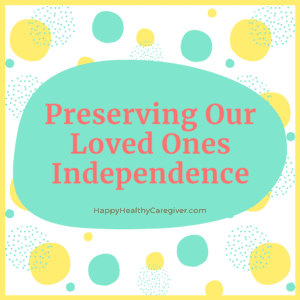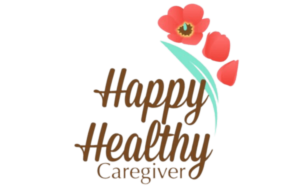This post is sponsored by HandsFree Health™. All opinions and statements are my own.
When someone we love begins to need help, our natural inclination is to do as much as we can for them. While the intentions are good, over a longer period, our continual help does not sustain a happy and healthy life for either party.
Sometimes we can help too much.
On the flip side, as family caregivers we frequently look for opportunities to maximize our time. We joke that we’d like to clone ourselves because the to-do lists are never-ending. One way to streamline our time is to ensure the loved ones we care for do as much for themselves as possible.

Aging in Place
I remember all the disagreements I had with my parents about wishing they would move closer to family so we could more easily be available for them. They lived in their dream home six hours away from the closest family member. After repeated arguments, they firmly let my family know they were not moving and intended to remain in their home for the remainder of their lives. I now know this popular mindset among our adult seniors is called ‘aging in place’.
I was not a fan of their decision since the once intermittent requests for support were becoming more frequent, but I had to learn to respect and accept their decision. They were so far away – I worried about their safety. How quickly could a family member get there if they needed us? I also questioned whether any of their children really had a sense of what was going on inside the four walls of their condo. None of these were unfounded concerns since my siblings and I saw a pattern of not being looped in until the situation became a crisis. I wished I could be a fly on the wall.

While my husband’s mom lived closer, she still needed our assistance and, in some cases, we worried more about her even more because she lived alone and was still driving quite a bit. At least my parents had each other and someone who came several days a week to help with personal and home tasks. My mother-in-law enjoyed her alone time so we feared it could be days before someone would become suspicious by not seeing or hearing from her. Although we offered for her to move in with us, she too wanted to remain in her apartment.
Benefits of Maintaining Independence
One of our roles as a care partner for a loved one is to help them maintain their activities of daily living and other personal responsibilities. Your care recipient may not vocalize their desire to remain independent but playing active role in daily life is important to one’s self-esteem and physical activity. No one wants to feel like a burden.
If your loved one still has cognitive abilities, consider having a courageous conversation with them about how you can partner together to maintain their independence. Managing expectations upfront can help prevent future frustrations.
Setting Boundaries
After my dad passed, my mom lived nearby in an assisted living facility. I had some peace of mind because professional caregivers were checking on mom several times a day. When she first moved in, I felt so guilty for leaving her alone. I visited all the time and also felt guilty that I was not there for my husband and children. Running in every direction and working a full-time job made me tired.
Out of fear of burnout, I had to set boundaries with mom about how much I was able to visit and assure her I would be there when I was really needed. In our case, mom maintained some of her independence by:
- doing her own online shopping
- making a list of all her requests instead of calling each time on popped up
- advocating for her own needs at the facility
- finding new activities to become a part of the community
Peace of Mind
Technology certainly helps our loved ones maintain independence or age in place.
One product that offers family caregivers peace of mind while maintaining independence for our loved ones is WellBe® by HandsFree Health™. WellBe is a virtual assistant offering personalized tools and interactive services for our care recipients while providing support to the care team. Caregivers can receive health-related notifications via text to stay in touch with their loved ones. Through the WellBe Virtual Assistant app, we can manage medication and appointment reminders as well as medical information. Essentially, WellBe can allow us to be that desired fly on the wall. Use code HAPPY to save $20 off your order and receive free shipping.
Take Action
Whether or not your loved one lives with you, talk through the main activities of daily living. Align on what adjustments to make so your loved one can complete the tasks. Sometimes small tweaks can make multi-step tasks more manageable or less worrisome.
Uncover the portions of each activity that your loved one can still do. Perhaps chopping vegetables for a salad is out of the question but setting the table is an option. While your loved one may not be able to put laundry away, maybe they can fold the laundry if someone brings the clean clothes to them. During shower time, some assistance may be needed getting in and out of the shower chair but your loved one can wash while someone is close by.
While the common term we use for our roles is ‘caregiver’, I like to think of us as ‘care partners’. Together we can help each other be happier and healthier.





